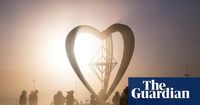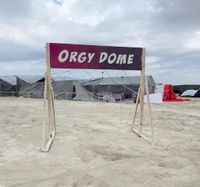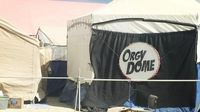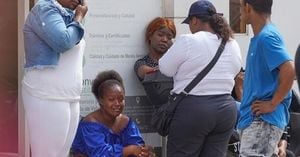It’s not every year that a dust storm leaves a mark on Burning Man quite like this. On August 26, 2025, the infamous Orgy Dome—a staple of the Nevada desert’s most eclectic festival—was destroyed by fierce winds that swept across Black Rock City. The loss of this iconic, sex-positive space has left many festival-goers reeling, while organizers scramble to regroup and keep the spirit of the dome alive.
Burning Man, the weeklong festival that transforms Nevada’s Black Rock Desert into a temporary city dedicated to radical self-expression, art, and community, attracts roughly 70,000 people annually. Since its beginnings in 1986 on San Francisco’s Baker Beach, the event has grown into a global phenomenon. But few installations have achieved the notoriety of the Orgy Dome, which since 2003 has offered a safe, consensual environment for couples and moresomes to explore sexuality, inclusion, and pleasure.
“Our build team worked so hard this past week to erect our lovely space,” organizers lamented in an Instagram post, as reported by Paste Magazine and Newsweek. “Unfortunately, the winds yesterday undid all that labor and wrecked our structure. We are still here and thankfully safe, we hope to gift the playa some workshops and will keep you updated.” It’s a bittersweet message—one that underscores both the disappointment and resilience of the Orgy Dome’s crew.
The destruction wasn’t limited to just the Dome. According to Billboard, another casualty was the “Black Cloud,” a 50-foot installation by a Ukrainian art team meant to honor their country’s ongoing struggles and stand as a monument against global conflict. The storm, with wind gusts approaching 50 miles per hour and localized flooding, didn’t discriminate in its path of chaos.
The National Weather Service had issued warnings for dust storms and thunderstorms in Northern and Central Nevada. “If you’re on the playa at the Black Rock Desert, you may very well be in for a muddy mess Monday through Wednesday,” the Reno NWS office cautioned, as cited by Newsweek. By the time the storm hit, the gate into and out of Black Rock City was closed. Organizers warned, “Rain is coming down, thunderstorms are present, and strong winds may follow. If you are in Black Rock City: Keep an eye out for lightning, take care of your camps, and stay safe. The playa is too wet to drive. Do not drive. Do not travel to BRC at this time.”
For many, the Orgy Dome was more than just a tent. It was a symbol of Burning Man’s commitment to consent, inclusion, and sexual exploration. The Dome required visitors to show physical ID, bring at least one partner, and, most importantly, obtain explicit verbal consent before participating. As the Orgy Dome’s website stated, “You are responsible for getting verbal consent before engaging.” One festival-goer summed up the ethos: “Verbal consent is necessary to begin play with other groups and to introduce new activities.”
Inside, the Dome was an oasis from the harsh desert—a private, air-conditioned space filled with mattresses, drapes, comfortable couches, and plenty of pillows. It was a place where, as LADbible described, “single people or swingers can experience a safe, consensual, sex-positive, inclusionary and exploratory environment.” The Dome’s reputation even sparked rumors of celebrity visits, with names like Jeff Bezos, Will Smith, and Elon Musk whispered among attendees, though such reports remain unconfirmed.
The 2025 festival has been particularly challenging. The event began on August 24, and by its second day, severe weather had forced organizers to temporarily halt activities. The destruction of the Orgy Dome was a harsh blow, but not the first weather-related setback for Burning Man. In 2023, a rare rainstorm stranded thousands of attendees in a mud pit, and in 2024, the festival’s opening day was marred by a fatality. The years 2020 and 2021 saw the event canceled entirely due to COVID-19 restrictions.
Despite these setbacks, the Orgy Dome’s organizers are determined not to let the winds have the last word. They’ve begun crowdsourcing materials to rebuild, calling for items like “eight ends 2 with zippers need points, 718 × 30 walls, ball bungees, 18 x 3015/8 pipe,” as detailed in an Instagram post. Their commitment to the community is clear: “We hope to gift the playa some workshops and will keep you updated.” Even if the Dome itself can’t be resurrected this year, the spirit of sex-positivity, education, and inclusivity will persist through alternative programming.
Burning Man’s culture is built on adaptability and resilience. The festival’s temporary city, Black Rock City, is constructed and deconstructed every year, embodying the principle of “Leave No Trace.” Installations come and go, but the ethos remains. The Orgy Dome’s destruction is a reminder of the unpredictability of the desert—and the tenacity of those who call it home, even if just for a week.
For those who planned to visit the Dome, the disappointment is palpable. But as Consequence quipped, “Guess there really is no keeping good-hearted perverts down for very long.” The Orgy Dome’s absence is “about as irksome as someone keeping their shoes on during group sex.” Still, the organizers’ vow to continue offering workshops and fostering a space for safe, consensual exploration keeps hope alive for future festivals.
Looking ahead, meteorologists say that while a few pop-up showers and thunderstorms could still occur during the remaining days of the festival, the worst appears to be over. AccuWeather’s Dan Pydynowski told Newsweek, “There will still be a small chance of a pop-up shower/thunderstorm Thursday and Friday, but rain chances tomorrow/Friday will be less than today’s.”
As Black Rock City recovers from the storm, the loss of the Orgy Dome is felt by many as the end of an era—but also, perhaps, as the beginning of a new chapter. Whether rebuilt or reimagined, the Dome’s legacy of sex-positivity, consent, and radical inclusion will endure, reminding everyone that, in the desert, nothing is ever truly permanent—except the spirit of Burning Man itself.






